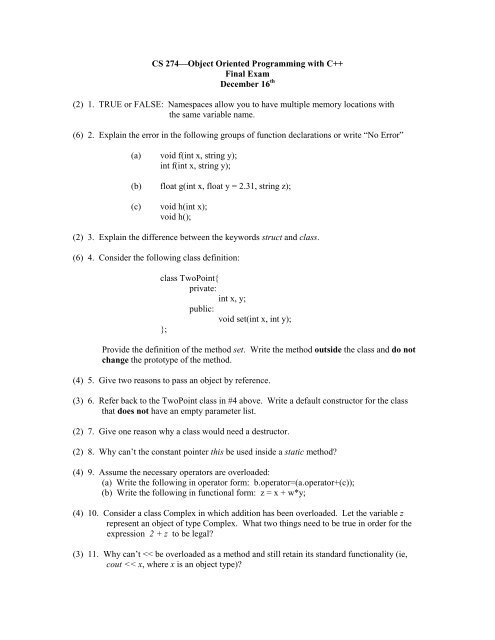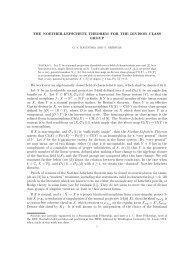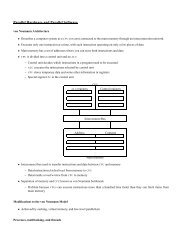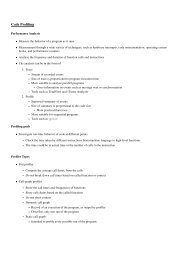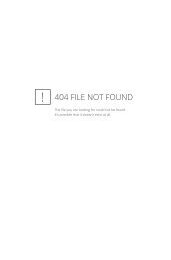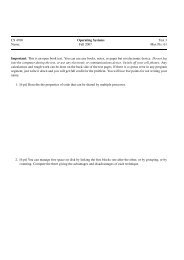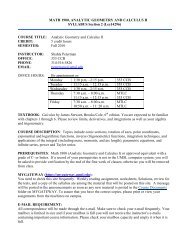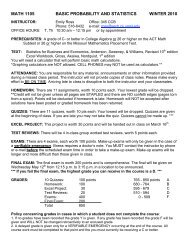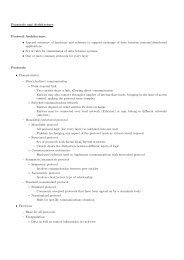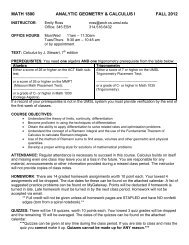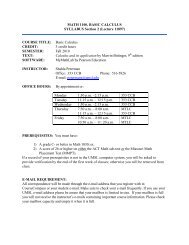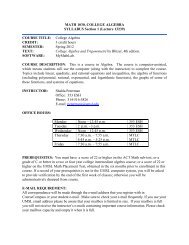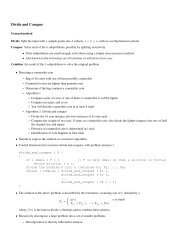CS 274âObject Oriented Programming with C++ Final Exam ...
CS 274âObject Oriented Programming with C++ Final Exam ...
CS 274âObject Oriented Programming with C++ Final Exam ...
- No tags were found...
Create successful ePaper yourself
Turn your PDF publications into a flip-book with our unique Google optimized e-Paper software.
<strong>CS</strong> 274—Object <strong>Oriented</strong> <strong>Programming</strong> <strong>with</strong> <strong>C++</strong><strong>Final</strong> <strong>Exam</strong>December 16 th(2) 1. TRUE or FALSE: Namespaces allow you to have multiple memory locations <strong>with</strong>the same variable name.(6) 2. Explain the error in the following groups of function declarations or write “No Error”(a)(b)(c)void f(int x, string y);int f(int x, string y);float g(int x, float y = 2.31, string z);void h(int x);void h();(2) 3. Explain the difference between the keywords struct and class.(6) 4. Consider the following class definition:class TwoPoint{private:int x, y;public:void set(int x, int y);};Provide the definition of the method set. Write the method outside the class and do notchange the prototype of the method.(4) 5. Give two reasons to pass an object by reference.(3) 6. Refer back to the TwoPoint class in #4 above. Write a default constructor for the classthat does not have an empty parameter list.(2) 7. Give one reason why a class would need a destructor.(2) 8. Why can’t the constant pointer this be used inside a static method?(4) 9. Assume the necessary operators are overloaded:(a) Write the following in operator form: b.operator=(a.operator+(c));(b) Write the following in functional form: z = x + w*y;(4) 10. Consider a class Complex in which addition has been overloaded. Let the variable zrepresent an object of type Complex. What two things need to be true in order for theexpression 2 + z to be legal?(3) 11. Why can’t
(2) 12. TRUE or FALSE: The assignment operator must be overloaded as a top-level function.(4) 13. Consider the following inheritance hierarchy:class A{protected:int x, y;public:int z;}class B: public A{private:int a, b, c;}(a) How many data members does B have?(b) How many of B’s data members are visible in B?(4) 14. Why is protected accessibility needed?(3) 15. Give an example of a case where virtual inheritance is necessary (ie, a casewhere you need virtual base classes in a multiple inheritance hierarchy.)(5) 16. Consider the following inheritance hierarchy:class A{public:int x;}class B: public A{private:int x;public:void set(int a, int b);}Write the definition for the method set that assigns the inputs a and b to B’s datamembers.(2) 17. TRUE or FALSE: If a base class has a default constructor, then none of the constructorsin the derived class need to explicitly call a base class constructor.(2) 18. TRUE or FALSE: If a base class has a parameterized constructor but no defaultconstructor, then derived class objects cannot be instanced unless thederived class constructor explicitly calls one of the base classconstructors.(2) 19. TRUE or FALSE: If a base class has no constructors whatsoever, then a derived classobject cannot be instanced.(3) 20. With which type of binding is the vtable used?
(2) 21. TRUE or FALSE: Virtual inheritance is necessary for polymorphism.(2) 22. What must you do if you want a class derived from an abstract base class to be nonabstract?(2) 23. Template functions and template classes contain at least one class parameter (typicallydenoted by T in the text). What does this class parameter represent?(2) 24. Fill in the blank: Container is to Iterator as Array is to __________________ .(25) 25. Write a program that reads in test scores and applies two different curves to them. Theprogram shouldContain a base class ScoreBank <strong>with</strong> two private data members: an integerpointer for the scores and a float for the average. The class should contain amethod EnterScores which asks the user how many test scores are needed,allocates enough memory, and reads in the scores. The class should also containa method CalcAverage which stores the average of the entered scores in theprivate float data member. Also have a Output function that prints a sorted list oftest scores to the screen (you may use the sort algorithm from STL: see page565) as well as the average. Be sure the class has an appropriate destructor.Derive from ScoreBank a class Curve1 which contains a method Curve. Thiscurve sets the average score to 75. Find out how far away from 75 the actualaverage is and then add this value to each test score. Overload the Outputmethod to print, sorted, the original scores and the curved scores as well as theoriginal and new average.Derive from ScoreBank a class Curve2 which contains a method Curve. Thiscurve sets the high score to 100 and scales the rest of the scores accordingly.Find the high score (you can use sort to do this) and divide all the scores by thisvalue. Then overload the Output function to print the original scores, the newscores, and the averages for both sets.Feel free to add any other methods or data members to the classes other thanthe ones I’ve mentioned if it will help you implement any of the requiredfeatures.Write a main function driver for these classes that creates objects of type Curve1and Curve2 and asks the user to input a list of test scores into each object andthen runs the Output functions from each object.


